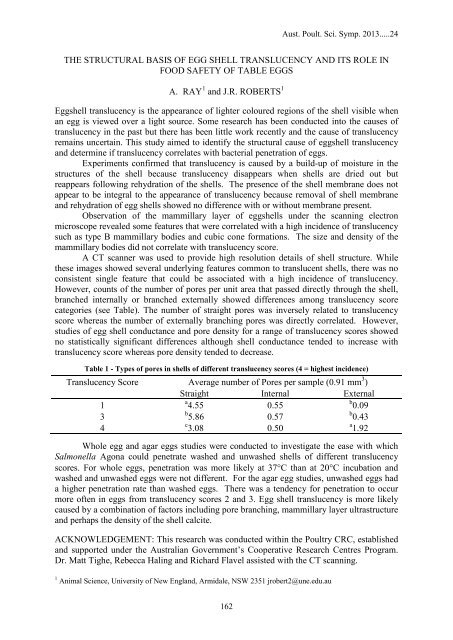APSS 2013 Proceedings - The University of Sydney
APSS 2013 Proceedings - The University of Sydney
APSS 2013 Proceedings - The University of Sydney
You also want an ePaper? Increase the reach of your titles
YUMPU automatically turns print PDFs into web optimized ePapers that Google loves.
Aust. Poult. Sci. Symp. <strong>2013</strong>.....24<br />
THE STRUCTURAL BASIS OF EGG SHELL TRANSLUCENCY AND ITS ROLE IN<br />
FOOD SAFETY OF TABLE EGGS<br />
A. RAY 1 and J.R. ROBERTS 1<br />
Eggshell translucency is the appearance <strong>of</strong> lighter coloured regions <strong>of</strong> the shell visible when<br />
an egg is viewed over a light source. Some research has been conducted into the causes <strong>of</strong><br />
translucency in the past but there has been little work recently and the cause <strong>of</strong> translucency<br />
remains uncertain. This study aimed to identify the structural cause <strong>of</strong> eggshell translucency<br />
and determine if translucency correlates with bacterial penetration <strong>of</strong> eggs.<br />
Experiments confirmed that translucency is caused by a build-up <strong>of</strong> moisture in the<br />
structures <strong>of</strong> the shell because translucency disappears when shells are dried out but<br />
reappears following rehydration <strong>of</strong> the shells. <strong>The</strong> presence <strong>of</strong> the shell membrane does not<br />
appear to be integral to the appearance <strong>of</strong> translucency because removal <strong>of</strong> shell membrane<br />
and rehydration <strong>of</strong> egg shells showed no difference with or without membrane present.<br />
Observation <strong>of</strong> the mammillary layer <strong>of</strong> eggshells under the scanning electron<br />
microscope revealed some features that were correlated with a high incidence <strong>of</strong> translucency<br />
such as type B mammillary bodies and cubic cone formations. <strong>The</strong> size and density <strong>of</strong> the<br />
mammillary bodies did not correlate with translucency score.<br />
A CT scanner was used to provide high resolution details <strong>of</strong> shell structure. While<br />
these images showed several underlying features common to translucent shells, there was no<br />
consistent single feature that could be associated with a high incidence <strong>of</strong> translucency.<br />
However, counts <strong>of</strong> the number <strong>of</strong> pores per unit area that passed directly through the shell,<br />
branched internally or branched externally showed differences among translucency score<br />
categories (see Table). <strong>The</strong> number <strong>of</strong> straight pores was inversely related to translucency<br />
score whereas the number <strong>of</strong> externally branching pores was directly correlated. However,<br />
studies <strong>of</strong> egg shell conductance and pore density for a range <strong>of</strong> translucency scores showed<br />
no statistically significant differences although shell conductance tended to increase with<br />
translucency score whereas pore density tended to decrease.<br />
Table 1 - Types <strong>of</strong> pores in shells <strong>of</strong> different translucency scores (4 = highest incidence)<br />
Translucency Score Average number <strong>of</strong> Pores per sample (0.91 mm 3 )<br />
Straight Internal External<br />
1<br />
a 4.55 0.55<br />
b 0.09<br />
3<br />
b 5.86 0.57<br />
b 0.43<br />
4<br />
c 3.08 0.50<br />
a 1.92<br />
Whole egg and agar eggs studies were conducted to investigate the ease with which<br />
Salmonella Agona could penetrate washed and unwashed shells <strong>of</strong> different translucency<br />
scores. For whole eggs, penetration was more likely at 37°C than at 20°C incubation and<br />
washed and unwashed eggs were not different. For the agar egg studies, unwashed eggs had<br />
a higher penetration rate than washed eggs. <strong>The</strong>re was a tendency for penetration to occur<br />
more <strong>of</strong>ten in eggs from translucency scores 2 and 3. Egg shell translucency is more likely<br />
caused by a combination <strong>of</strong> factors including pore branching, mammillary layer ultrastructure<br />
and perhaps the density <strong>of</strong> the shell calcite.<br />
ACKNOWLEDGEMENT: This research was conducted within the Poultry CRC, established<br />
and supported under the Australian Government’s Cooperative Research Centres Program.<br />
Dr. Matt Tighe, Rebecca Haling and Richard Flavel assisted with the CT scanning.<br />
1 Animal Science, <strong>University</strong> <strong>of</strong> New England, Armidale, NSW 2351 jrobert2@une.edu.au<br />
162
















